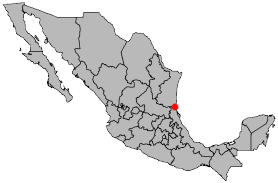Tampico Expedition facts for kids
The Battle of Tampico happened on November 15, 1835. It took place in Tamaulipas, a state in Mexico. In this battle, General José Antonio Mexía and about 150 American volunteers fought against Gregorio Gómez and the Mexican Centralist soldiers. This fight was part of a bigger rebellion against General Santa Anna. The battle's result was important for the future of the Texas War of Independence.
Why the Battle Happened
After General Santa Anna became President of Mexico in 1833, he let his vice president, Valentín Gómez Farías, handle much of the government. The vice president started making big changes. These changes especially affected the Mexican Army and the Catholic Church. Powerful groups who liked the old ways got angry. They asked Santa Anna to come back and take control.
Santa Anna agreed and stopped the changes. He made Gómez Farías and his supporters leave Mexico. These supporters were called Federalists. They believed in a government where power was shared more, like in the Mexican Constitution of 1824. Santa Anna and his group were Centralists, who wanted a stronger central government.
When a revolt began in October 1835, most Texas colonists were still loyal to Mexico. A meeting called "The Consultation" happened in San Felipe de Austin on November 7, 1835. The Texans said they were fighting to protect the ideas of the 1824 Mexican Constitution. This statement encouraged Santa Anna's opponents who were living in the United States.
General José Antonio Mexía and other opponents of Santa Anna went to New Orleans, USA. There, they planned to fight the Centralist government. Mexía believed that capturing Tampico, Mexico, would be a major blow to Santa Anna's power.
The Ship Mary Jane
In October 1835, General Mexía gathered a fighting force in New Orleans. His goal was to help the Federalist groups in the Mexican state of Tamaulipas. On October 29, Mexía told Texan leaders about his plan. He had hired an armed ship called the Mary Jane.
The ship carried a large cannon and two smaller cannons. It had a crew of 50 men, ready for three months. Plus, 150 more men were ready to fight on land. Later, it was reported that the group included:
- A company of 52 grenadiers (soldiers with special training).
- A company of 42 sharpshooters (skilled shooters).
- 33 French and Creole volunteers.
- 15 marines (soldiers who fight on ships).
The expedition left New Orleans on November 6, 1835. The ship's captain, Richard Hall, said they were going to Galveston and Matagorda in Texas. The cargo listed things like flour, beef, fish, and potatoes.
Five days later, a storm hit the ship. The crew told the volunteers that the Mary Jane was actually going to Tampico, not Texas. On November 14, the ship reached the mouth of the Panuco River near Tampico. When a local pilot came to guide the ship, Mexía learned that no one in Tampico knew they were coming. Before the ship could enter the port, another storm blew in. The ship ran aground (got stuck). Water began to leak into the ship. Mexía ordered his men to throw some cannons and supplies overboard. He hoped this would make the ship lighter and free it.
Captain John M. Allen and Captain Hall went ashore with six sailors. They went to the fort that guarded the port. The fort had 24 soldiers and three large cannons. These soldiers quickly gave up the fort to Mexía's forces. Even better, they joined Mexía's side!
The Fight at Tampico
Mexía and his 150 supporters waded ashore. They spent some time drying their clothes and gear. On November 15, they tried to capture the important city of Tampico. Most of Tampico's soldiers, led by Gregorio Gomez Palomino, were loyal to the Centralist government. Any Federalist supporters in Tampico had already been defeated.
The loyal soldiers knew Mexía was landing. They had strengthened the Tampico customs house (a building where taxes on goods are paid). They also had more soldiers join them from the Tuxpan Battalion.
Mexía's Federalist troops entered Tampico and reached the customs house. A guard outside saw them, and shooting began. The soldiers inside the customs house fired cannons, killing two of Mexía's men. Mexía's invaders rushed the cannons and killed three of the defenders. The battle lasted about two hours. Mexía's men captured the customs house and two cannons. This forced the defenders to retreat into a nearby fort.
By this time, Mexía's men had used up most of their ammunition. So, Mexía ordered a retreat. Mexía and his supporters boarded an American ship called the Halcyon. This ship took them to the mouth of the Brazos River in Texas.
What Happened Next
Thirty-one of the men who arrived on the Mary Jane were captured. Three of them died from their wounds. The remaining twenty-eight were executed (killed) on December 14, 1835.
Mexía's defeat showed many Texians (people living in Texas) that Mexico's Federalists would not be able to help them. This caused bad feelings between these groups who could have been allies. Also, the Mexican government said that Mexía's expedition was made up of "pirates." They executed the men Mexía left behind. This policy of "no quarter" (meaning no mercy or prisoners) was then applied to the Texas situation in something called the Tornel Decree.


